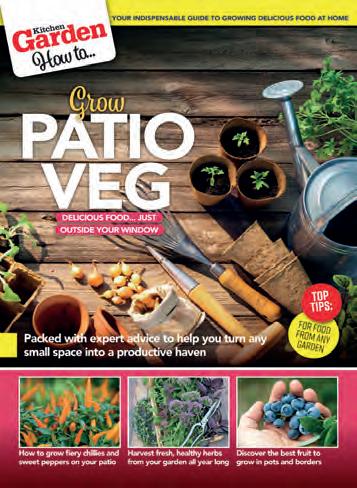MONTHBY MONTH
All you need to know to pick nutritious food from your garden, allotment or greenhouse

Gather delicious strawberries fresh from your garden

Discover the secrets of growing tasty potatoes

Packed with practical tips and advice to save you cash

YOUR INDISPENSABLE GUIDE TO GROWING DELICIOUS FOOD AT HOME
EXPERT ADVICE FOR SEASONAL GROWING AND HARVESTING £9.99








Order today at www.classicmagazines.co.uk/howtoseries or call our Customer Services team on 01507 529529 Fresh from the publisher of Kitchen Garden magazine, Britain’s best-selling publication for those growing their own fruit and veg, is a new series designed to show you ‘how to’ get the most from your outdoor space. Whether you’ve a large back garden or just a small patio, the Kitchen Garden How To guides are perfect for beginners and experienced gardeners alike. Priced at just £9.99 they come packed with great advice from experts, plus up to 15 packs of seeds worth at least £20 and are just what you need to get growing. Save 20% when you purchase a bundle with 2 or more bookazines! Pick delicious strawberries fresh from your garden All you need to know to pick nutritious food from your garden, allotment or greenhouse Discover the secrets of growing tasty potatoes Packed with practical tips and advice to save you cash YOUR INDISPENSABLE GUIDE TO GROWING DELICIOUS FOOD AT HOME forgreat home-grown treats! Top tricks: MONTHBY MONTH EXPERT ADVICE FOR SEASONAL GROWING AND HARVESTING FROM THE PUBLISHERS OF SUBSCRIBE TO THE ‘HOW TO’ SERIES & SAVE 20%!
AUTUMN – LIFT AND STORE CARROTS

Editor: Steve Ott, sott@mortons.co.uk
Deputy editor: Emma Rawlings, erawlings@mortons.co.uk

Staff writer: Tony Flanagan, tflanagan@mortons.co.uk
Advertising: Craig Amess, camess@mortons.co.uk Tel. 01507 529529
WELCOME
Whether you are new to gardening and are growing fruit and vegetables for the rst time or an old hand who just wants a reminder of the essential tasks to carry out on your plot each month, this bookazine is for you.
Written by Kitchen Garden experts, themselves keen and experienced growers, How to Grow Month-by-Month takes you through the gardening year, covering many popular crops in detail and o ering plenty of top tips along the way. Each month includes simple step-by-step advice that will help you become familiar with many of the basic techniques you’ll need to help you produce fresh, nutritious fruit and vegetables from your garden or allotment all season long. ese range from growing strawberries in hanging pots to sowing and planting cabbages and leeks, to propagating fruit and storing onions.
ere is also plenty for those with a greenhouse or polytunnel – each month includes lots of advice for growing protected crops, allowing you to take advantage of the warmth and shelter to extend your season by several months.


Finally, if this is your rst attempt at growing your own, turn to page 80 to discover gardening expert Emma Rawlings’ advice on starting a new veg plot from scratch. Happy gardening!

Acknowledgement: Month-by-Month words and pictures by Kitchen Garden regular contributor Martin Fish unless otherwise stated.
Steve Ott Editor, Kitchen Garden magazine www.kitchengarden.co.uk

4 Month-by-Month at a glance. Your instant guide to the year’s essential jobs
72

Design: Burda Druck India Pvt. Ltd.

Publisher: Steve O’Hara
Published by: Mortons Media Group Ltd. Media Centre Morton Way Horncastle Lincolnshire LN9 6JR







Printed by: William Gibbons and Sons, Wolverhampton
BARCODE: 5059464134009

6 January 12 February 18 March 24 April 30 May 38 June 44 July
August
September
October
November
50
56
62
67
December
Reader
78-79
offers
scratch
80 Starting a new plot from
© 2022 Mortons Media Group Ltd. All rights reserved. No part of this publication may be reproduced or transmitted in any form or by any means, electronic or mechanical, including photocopying, recording, or any information storage retrieval system without prior permission in writing from the publisher.
www.kitchengarden.co.uk | 3 WELCOME SEASONAL HIGHLIGHTS
CONTENTS
WINTER – SOW ONIONS
SPRING – PLANT A HERB POT
SUMMER – HARVEST BEANS
7 31 50 63
AT-A-GLANCE
YOUR INSTANT GUIDE TO THE YEAR’S ESSENTIAL JOBS
PLAN YOUR SOWINGS

Plan what you intend to grow in the garden this season. It’s well worth working out some sowing dates for a continuous supply of salads and vegetables.














CLEAR AWAY CABBAGES


As you harvest winter cabbages and Savoys their old stems can be pulled out of the garden to gradually clear the ground.


ORDER POTATOES
Buy seed potatoes as soon as possible to make sure you get the best choice of varieties.













FORCE RHUBARB


Cover established rhubarb that wasn’t forced last year with a large bucket or forcing pot to exclude all light. This will encourage the tall, very pale sticks that are wonderful to eat in spring.
CLEAN COLD FRAMES
To get ready for the busy growing season in spring give your cold frame a good wash with warm soapy water to remove dirt from the glass and give the frame a good scrub.
PROTECT WITH FLEECE


Protect any early sowings of vegetables such as broad beans with garden fleece. Even if the pots or trays are in a greenhouse or polytunnel the fleece will give a little protection on cold nights.








COMPOST BRASSICA STALKS
As soon as winter brassicas such as Brussels sprouts and winter kale have been picked, the old stalks can be pulled out of the garden, chopped up and composted.
ATTEND TO RASPBERRY CANES








As summer raspberry canes start into growth, now is a good time to trim off any dead ends to the canes that have died back over the winter. Snip back to a strong, healthy bud.
MONITOR SOIL TEMPERATURE












If you have a probe soil thermometer, push it into the vegetable plot to see what the temperature is a few inches down. Sowing can start once it is showing 7C (45F).

CHECK ASPARAGUS



The cutting season traditionally starts on April 23, St George’s Day, but in mild weather spears can start to push through a week or two earlier. Start cutting when the spears are 15cm (6in) tall.

FEED SOIL


April and May are the main months for sowing vegetable seeds outside. To make sure the plants have a good supply of nutrients through the growing season, feed the soil before sowing with a general, balanced fertiliser.
PREPARE FOR SOWING

Spring is a busy time and the more you can prepare in advance the better. Take a little time to sort out seed packets into sowing times.

MONTH BY MONTH
MARCH APRIL FEBRUARY
JANUARY
HARDEN OFF TENDER VEG
Tender vegetables that have been started off under cover can be hardened off over the next few weeks in a cold frame to prepare them for planting out once the danger of frost has passed.

PROTECT POTATOES
In many parts of the country there is still a chance that we’ll get some night frosts through May. To protect soft growth such as potatoes pushing through the soil, keep some fleece handy.
THIN YOUNG SEEDLINGS
Spend just a few minutes thinning rows of seedlings when they are large enough to pull out. This will allow them plenty of room to develop and grow properly over the summer.
SEPTEMBER
REMOVE OLD CROPS
Once summer crops have finished cropping or when they run to seed, chop them up and add to the compost heap. The ground can then be prepared for planting spring cabbages.
HARVEST GARLIC
If you haven’t lifted your spring planted garlic, now is the time to ease the bulbs out of the soil with a fork. Dry and store for winter use.
CHECK APPLES
As a rule of thumb, apples are ready to pick when the fruits leave the tree without too much pulling. If you have to tug, try them in another week.
PROTECT PEA SHOOTS
As pea shoots start to push through the garden soil make sure you protect them from hungry pigeons, otherwise they will quickly peck off the new growth.
PINCH OUT BROAD BEANS
Broad beans should be growing well now and well on the way to producing a crop of tasty beans. If not already done, the tips of the plants can be pinched out to deter blackfly.
PLANT LEEK SEEDLINGS
It’s now time to plant leeks seedlings out into the garden. If the weather is dry after planting, keep the seedlings watered for a week or two to help them establish a strong root system.
OCTOBER
HOE WEEDS
Weeds will make a last attempt to grow and produce seed before winter sets in. Use a Dutch hoe and chop off any seedlings at soil level while they are small.
BUY GARLIC BULBS
Buy bulbs of garlic for autumn planting from local garden centres or specialist growers. These will be varieties that are suitable for growing in our climate.
EXPOSE RHUBARB CROWNS
As soon as we start to get some cold nights the large leaves of rhubarb collapse and turn yellow. Pull the old growth from the plant to expose the crown to the cold weather.
FEED TOMATOES

It’s important that tomato plants get plenty of nutrients, especially potash, so feed once a week with a high potash fertiliser to help the fruits develop and ripen.


CHECK APPLE TREES
When the natural ‘June drop’ on apples has finished, which is often July in the north, check to see how much fruit has remained. On cooking apples aim for one or two fruits per cluster and on eating varieties leave two or three.
LIFT GARLIC
Lift bulbs of garlic from the garden as you need it or when the foliage starts to die down. When freshly lifted it has a sweet flavour and if allowed to dry naturally it will store for months.
NOVEMBER
CHECK APPLES
Check apples that are being stored for winter use and pick out any that are turning soft or starting to show rot, as it develops very quickly and will spread to other fruits.
CLEAR GUTTERS
The leaves on trees are falling fast now and it’s important that you make sure they are not blocking gutters and down pipes on sheds and greenhouses.
INSPECT FIG FRUIT
Check over fig trees and pinch off any fruits that are larger than your little fingernail as these won’t overwinter. Any very small, embryo fruits in the tips of the branches should be left on.
FEED ASPARAGUS
Asparagus should be producing tall, ferny foliage. To help build up the roots for next spring feed the plants with a general fertiliser and water thoroughly in dry weather.
CHECK COMPOST HEAP
If the contents of your heap are very dry they won’t break down, so add some water and give everything a good mix-up to get the heap working again.
WATCH OUT FOR BLIGHT
Potato or tomato blight usually starts in warm, humid conditions after a period of damp weather and will show as brown spots on the foliage that if not picked off will spread quickly.
DECEMBER
PROTECT BROAD BEAN PLANTS
Broad beans sown in October or November should be through now and making strong plants in the plot. If birds are a problem, cover them over with wire netting.
WEED BETWEEN CABBAGES
Always keep young spring cabbage plants weed free. It’s also a good idea to use a hoe to draw up a little soil around the stems to prevent them from rocking in windy weather.
COLLECT WINTER RAIN
Take advantage of winter rains to collect as much water as possible in water butts from shed and greenhouse roofs.
JANUARY 2021 | 5
MAY
JUNE
JULY
AUGUST
MONTH BY MONTH AT A GLANCE
JANUARY 10 MINUTE JOBS
PICK KALE LEAVES
One of the hardiest of winter veg is the Tuscan or black kale. It’s a very tasty leaf vegetable and is packed full of goodness. Picking it is very simple and it only takes a few minutes to pull off enough leaves for a meal.

STOCK UP ON FERTILISERS
Before spring, check what dried fertilisers you have in the shed, such as Growmore, dried pellets, blood, fish and bone and work out if you’ll have enough for the coming season. If not get stocked up, so that come the growing season you’ll be prepared.
ORDER SEED POTATOES
If you buy your seed potatoes by mail order, get your order in as soon as possible to make sure you can get the varieties that you want. Alternatively, if you buy from a local garden centre or nursery, give them a call to ask when they’ll be in.
INSULATE OUTDOOR TAPS
In frosty weather check outdoor taps to make sure they are well insulated and if not, wrap them in fleece, hessian or fit a polystyrene cover. Better still, isolate the tap at the stop-cock to prevent pipes freezing and only turn it on when needed.
CHECK GREASE BANDS
If you fitted grease bands around your fruit trees in autumn to prevent the wingless females of the winter moth from climbing the trunk to lay eggs, check the bands now and change for fresh bands, or apply some fresh grease if they are drying out.
HOW TO GROW MONTH BY MONTH
STEP BY STEP SOWING ONIONS





STEP 1: For good germination, use either a John Innes compost or mix or half and half John Innes and a decent quality multipurpose. Over- ll the tray with compost, strike it o level with the top of the tray and then use a presser board to gently rm the compost down approximately 10mm (½in) from the top of the tray. What we want is a level, even, lightly rmed surface.


STEP 3: Covering is just as important and whatever you use it needs to be an even thickness. If using compost use a ne sieve and cover with approximately 5mm (¼in) of compost. Alternatively, use vermiculite which is very easy to spread over the seeds. It’s very good at maintaining moisture around the seeds while they are germinating and the seedlings can push through without any problems.
STEP 2: Even sowing, not too thickly is very important to get an even batch of quality seedlings that will all grow at the same rate. Sow the seeds straight from the packet, sowing evenly across the whole surface. Onion seeds are black and angular and di cult to see on the compost, but if you get down low and look across the compost you can see them.

JANUARY www.kitchengarden.co.uk | 7
PURPLE SPROUTING BROCCOLI

One vegetable we always look forward to in March and April is purple sprouting broccoli. The tasty heads are full of flavour and come at a time when other winter veg is coming to an end, making them very welcome. From sowing to harvesting is almost a year, but it’s worth the wait. The plants can grow to be tall and very often they get top heavy and topple over and lay along the ground. To give them some support and keep them upright, use short, stout canes pushed into the soil at the side of the plants and tie them securely with soft string.
REMOVE DEAD LEAVES FROM LEEKS
Leeks are a great winter vegetable to grow in the garden and it’s possible to have them in season from October through until May. Generally speaking, they are fairly easy to grow and being hardy they can remain outside in the garden all winter.
At this time of the year when the leeks are ready to harvest it’s natural for the lower leaves to shrivel, either as a result of lack of light or fungal infection similar to grey mould. Although not harmful to the main plant, it’s a good idea to clear the old leaves from around the plants and dispose of them. This helps keep the leeks healthy and prevents diseases spreading.

8 | www.kitchengarden.co.uk
SOW NOW
Onions, lettuce and salad leaves, broad beans – all under cover with heat.
PLANT NOW
Soft fruit bushes, cane fruit and fruit trees, garlic in pots, rhubarb.
PRUNE REDCURRANTS
Red and white currants can be summer and winter pruned. The aim when pruning is to develop an open framework of old

wood from which grow lots of side shoots. The growth made last summer can be shortened to form short fruiting spurs along
the older stems. Any congested growth can also be thinned out slightly and tall vertical shoots reduced to keep the shrub in hand.
HARVEST
Brussels sprouts, winter cauliflower, kale, Savoy, winter cabbage, leeks, celeriac, chard, Swede, Jerusalem artichokes, spinach, parsnips.
IN STORE
Apples, pears, potatoes, beetroot, carrots, squash, pumpkin, onions, shallots.
APPLE
TREE PRUNING
Continue to prune apple trees, but don’t get carried away and prune out too much wood as this will simply encourage even more strong new growth in spring. Winter pruning should be structural to develop a good framework. Any crossing branches can be removed and if the centre of the tree is congested, thin it out a little. Tall vertical growth can be reduced to a lower, side-ways growing branch.

JANUARY
PLAN A CROP ROTATION







ere are many bene ts of rotating crops each season (i.e. not growing the same crops in the same soil every year) and it can certainly help to prevent a build-up of pests and diseases in the soil. With a four-year rotation, each plot is composted or manured every other year which keeps the soil in good condition.
A four-year rotation consists of four beds, but if growing on a large plot or allotment, you can divide the area into four sections. Beds are used to grow legumes, root-crops, onions and brassicas and the crops rotate clockwise a bed each year, meaning it’s four years before the same crops are grown in that bed again. For crops that don’t t into
the rotation such as salads, courgettes and sweetcorn, simply plant them in one of the other beds where there is space.
e brassica bed follows on from legumes and they can take advantage of the nitrogen xing nodules left in the soil from peas and beans. e bed is dug over in late winter, with no added compost or manure. After digging, garden lime is applied to maintain alkaline conditions and allowed to wash in naturally. General fertiliser such as Growmore or blood, sh and bone is applied before planting. Onions, including garlic, shallots and leeks follow on from the brassicas and take advantage of the
Do iT now
lime residue. is bed is composted or manured when it’s dug and in spring it receives a dressing of general fertiliser to give the onions a good start. Root vegetables such as early potatoes, carrots, parsnips follow on from the onion bed. e soil is dug over in winter and left until spring when it’s raked down and general fertiliser is applied a week or so before sowing or planting. No compost or manure is used in this bed.
e legume bed where peas and beans are grown follows roots and is dug in late winter, composted or manured and fertiliser is applied in spring to supply additional nutrients.
■ Cold frames that are used to overwinter plants or that will be needed in spring can be given a good wash down to clean the glass and wash off algae


■ Carry on digging the veg plot when conditions are suitable. The golden rule is never dig in very wet conditions as it puddles the ground, or when it is frozen solid.

■ As the new seed catalogues arrive, spend a little time looking though them and decide what varieties you want to grow this year and get them ordered as soon as possible.
■ Check vegetables and fruit in store as by this time of the some of them will be starting to show signs of rot. Any that are spoiling need removing as using straight away.
■ On wet days when you can’t garden, give the shed a good sweep out and clean your tools to get them ready for spring.
10 | www.kitchengarden.co.uk HOW TO GROW MONTH BY MONTH
IN THE GREENHOUSE PREPARE FOR GROWING
January is one of the least productive months in the greenhouse and polytunnel, when it comes to harvesting crops, but it’s a time when there is lots of preparation to do ready for the new growing season.
Making sure the glass in the greenhouse or polythene on the polytunnel is clean is something that needs doing before the main growing season. A bucket of warm, soapy water and a car-washing brush is ideal to scrub o dirt and algae which will instantly allow more light to new crops in spring. While you’ve got the bucket of warm water, it’s also a good idea to give the propagator a good wash down to remove dirt and fungal spores to help seedlings get o to a healthy start.

POT STRAWBERRY PLANTS
For an early crop of strawberries in May and June, now is the time to bring some plants under cover to start them into growth. Strawberries need a period of cold weather outside to break their winter dormancy, but when brought under cover in mid to late January, they soon start to wake up and make new growth. Last year’s runners can be lifted from the garden, or new plants in small pots can be potted into larger containers or hanging baskets using good quality compost. Keep the compost moist and stand the pots on a bench in a light position. Even without any arti cial heat, the plants will ower and produce delicious fruit a few weeks earlier than plants growing in the garden.
WHAT TO DO IN JANUARY

1 Clear out the last of any winter crops that have now finished, chop them up and add to the compost heap.
2










Prune back tall shrubs and overhanging branches on trees that cast shadows on the greenhouse.
3 Check perennial herbs in pots and if the compost is starting to dry out, give them a little water.
4 Make sure you’ve got your seed order in if you buy from a mail order company, to get the varieties you want.

5 Check garlic cloves that were started into growth in pots last autumn and keep them just moist.
6 Tidy pots and seed trays and dispose of any that are broken or no longer used.

JANUARY www.kitchengarden.co.uk | 11
FEBRUARY 10 MINUTE JOBS
SPREAD COMPOST
When you get a little spare time on the plot, start to dig out well-rotted compost from the compost heap or bin and tip it around the garden in piles where needed. If the ground is frozen hard, all the better to prevent making a mess.

WASH POTS AND TRAYS
It’s always good to start the growing season with clean pots and trays, so when it’s too cold or wet to garden, spend a little time in the shed with a bucket of warm soapy water and give your plant pots and seed trays a good wash.
CHIT POTATOES
When you buy or take delivery of early varieties of seed potatoes start to ‘chit’ them straight away to prepare them for planting in several weeks’ time. The ideal conditions for this is a light cool place to encourage short, stocky growth.
HEEL IN FRUIT BUSHES
Fruit trees and bushes that were planted in the autumn or over winter can be checked to make sure the roots haven’t been loosened in frosty weather. If the soil is soft or the roots have been heaved out, firm them with the heel of your boot.
HOW TO GROW MONTH BY MONTH












































































































































